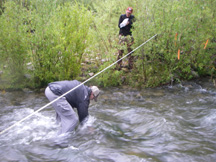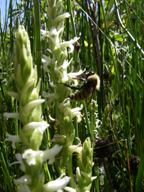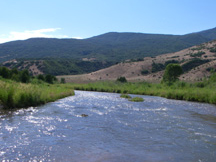Diamond Fork and Sixth Water Creeks
Diamond Fork and Sixth Water Creeks Riparian Vegetation, Geomorphic, and Benthic Macroinvertebrate Monitoring

 BIO-WEST conducted long-term channel geomorphology, sediment-transport, benthic macroinvertebrate, and riparian vegetation monitoring of Diamond Fork and Sixth Water Creeks. These two streams were significantly altered by water imports from Strawberry Reservoir and the Central Utah Project. A pipeline was constructed to carry excess imported water (350 cubic feet per second) that was previously conveyed through the Diamond Fork Creek and Sixth Water Creek channels. This project was part of the Utah Reclamation Mitigation and Conservation Commission to collect data on how the stream and its riparian ecosystem adjust to the re-naturalized hydrology to help determine whether active channel restoration efforts will be necessary in the watershed.
BIO-WEST conducted long-term channel geomorphology, sediment-transport, benthic macroinvertebrate, and riparian vegetation monitoring of Diamond Fork and Sixth Water Creeks. These two streams were significantly altered by water imports from Strawberry Reservoir and the Central Utah Project. A pipeline was constructed to carry excess imported water (350 cubic feet per second) that was previously conveyed through the Diamond Fork Creek and Sixth Water Creek channels. This project was part of the Utah Reclamation Mitigation and Conservation Commission to collect data on how the stream and its riparian ecosystem adjust to the re-naturalized hydrology to help determine whether active channel restoration efforts will be necessary in the watershed.
Specific Monitoring Activities

- Establishing permanent channel monitoring sites/transects
- Annually surveying channel crosssections and longitudinal profiles at the monitoring sites
- Annually mapping channel substrate composition
- Collecting bedload and suspended-sediment samples during spring runoff
- Collecting spring and fall macroinvertebrate samples
- Mapping riparian vegetation including monitoring permanent transects across different floodplain surfaces to quantify change in species composition, density, structure (i.e., habitat) following implementation of the Diamond Fork System
BIO-WEST also monitored populations of Ute ladies’-tresses (Spiranthes diluvialis), an endangered orchid known to exist along Diamond Fork Creek.

